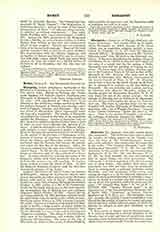

Hierapolis, titular, archdiocese, metropolis of the Province of Euphrates, in the Patriarchate of Antioch. The native name, Mabog or Maboug, the Greeks make Bambuke and Seleucus Nicator transforms into Hierapolis or Hieropolis, both forms being found on the coins. This appellation of “Holy City” is an allusion to the celebrated temple erected to the Syrian goddess Atargatis or Derceto, who was also venerated at Palmyra, Ascalon, and elsewhere. The dove was sacred to this goddess, who is represented under the form of a woman-fish. The temple of Hierapolis was pillaged by Crassus at the time of his expedition against the Parthians. Lucian of Samosata tells us that numerous pilgrims repaired thither twice a year in order to pour water through the opening of an abyss. Under the Seleucides and the Romans, Hierapolis became a great commercial center, a halting-place for the caravans going from Seleucia to Babylon. As the capital of the province of Commagene, or Euphrates, it became an important military stronghold where the Roman and Byzantine armies were concentrated, once the Persians had crossed the frontier and taken the first line of the defenses. Julian the Apostate stopped here for some days before marching against Sapor. In 540 the city escaped pillage by the troops of Chosroes only by the payment of a heavy fine. Justinian fortified it, reducing the extent of the ramparts, which, with their numerous towers, also built by this emperor, are still standing. It requires about an hour to make the circuit of them. In 1068 the Emperor Romanus Diogenes took the city, thus staying the progress of the Turks.
Lequien (Or. Christ., II, 925-8) names ten bishops of Hierapolis. Among the best-known may be mentioned Alexander, an ardent advocate of the Nestorian heresy, who died in exile in Egypt; Philoxenus or Xenaia (d. about 523), a famous Monophysite scholar; Stephen (c. 600), author of a life of St. Golindouch. Under the Patriarch Anastasius, in the sixth century, the metropolitan See of Maboug had nine suffragan bishoprics (Echos d’Orient, 14, 145). Chabot (Revue de l’orient chretien, VI, 200) mentions thirteen Jacobite archbishops from the ninth to the twelfth century. One Latin bishop, Franco, in 1136, is known (Lequien, III, 1193). This see must not be confounded with Hierapolis in Arabia, a large number of whose titulars in the fifteenth century are mentioned by Eubel (II, 181). Today Membidj is a caza of the sanjak and vilayet of Aleppo in a rich plain. The village is situated twenty miles west of the Euphrates, and contains 1500 inhabitants, all Circassians. The ruins of the city of Hierapolis are thirteen miles north, at Kara-Membidj, where remains of aqueducts and the Byzantine walls of Justinian are still to be seen.
S. VAILHE

